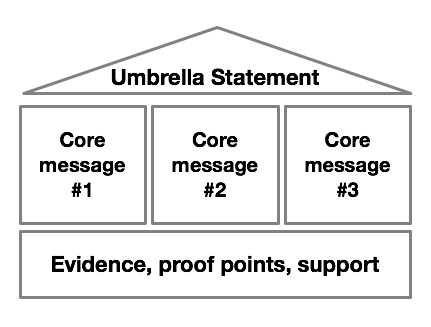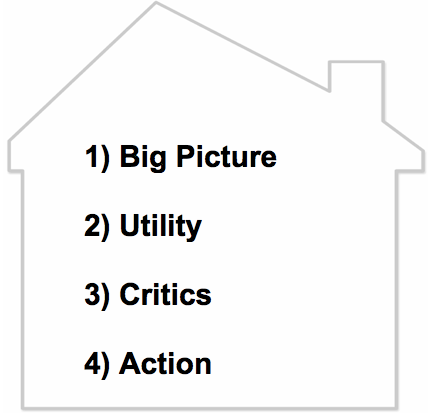You might have seen a Message House style that’s different from the one here on MessageHouse.org. This other approach has an “umbrella statement” inside the roof; underneath the roof it has three “rooms”, each containing a different “core message”; and below those three rooms is one “foundational” space containing “evidence, proof or support.” Let’s call it the “3-room message house style”.
The Message House template on this site, on the other hand, only has one “room” for all its messages, and the messages are always titled “big picture”, “utility”, “critics” and “action”. Let’s call it the “MessageHouse.org approach”.
Needless to say: There is no right or wrong way of doing message houses. The “3-room” is a fantastic step forward if you’ve never used Message Houses before. It might even be perfect for you.
But I wanted to share the three reasons why we at the Message House Group have arrived at the particular style of Message House that we use:
1) Structure
The 3-room message house requires users to create an umbrella statement and three core messages. I must admit that this was pretty much the way I used to go about coming up with my messages. I’d meditate, and wonder “what’s the most important message?” and “what are the next three most important messages?”
It’s a somewhat unsystematic, unguided approach.
The MessageHouse.org way, on the other hand, uses a structured approach, leading us to core messages by asking a standard set of four questions about the larger picture, the immediate utility, the most likely criticism and the call to action.
It’s like having a roadmap for your conversation about your messaging; and it pretty much always leads to useful results. It also provides an agenda of sorts for team meetings in which you discuss your messages. Over all, I’ve found that this structured approach leads to better, more high-quality messages.
2) Brevity
Three-room style message houses tend to pack a lot of text, especially since they invite to also include proof points, supporting materials and evidence into the space on the bottom (although this can, of course, be avoided).
The MessageHouse.org approach, on the other hand, tends to lead to briefer amounts of text by seeking only four messages. It advises to put proof points, and supporting materials such as answers to dicey questions and faq-style information into separate documents.
Here’s why such brevity is useful: The MessageHouse.org approach is not just about creating messages and messaging discipline for a project or organization. It’s also about creating the habit of using Messages Houses. Keeping Message House short helps a great deal in creating this habit. The shorter they are, the more likely an organization’s staff will like them, ask for them and make a habit of using them.
The idea is to get your staff to think of Message Houses as something that makes life and work easier, lighter, clearer. That’s why you want brevity and clarity in your Message Houses.
Also, brief messages are more likely to be used when it matters. When time is scarce (say, just before a speech or a media interview) people will be more inclined to glance over a very concise set of messages, as opposed to a densely packed document that takes minutes rather than seconds to read.
Again, this does not mean you don’t need proof points, supporting materials, and the like. But the idea is to put them into separate documents so we get the benefit of having one core document that is brief, clear and essential.
Less is more!
3) Practical
Message Houses are sticky, in large part because of the visual metaphor of the house. The image of “staying inside the message house” resonates with people, much more than the abstract concept of a set of key messages. But often it will still be appropriate to send the messages in the good old-fashioned bulleted way – even if the message house image gets lost in the process. For instance, if time is of the essence, then you don’t want to force somebody to open an attached pdf or word document (which would retain the message house visual and template). Instead, you want to place the messages inside the main body of an email, just as bullets, so they can be glanced at quickly without having to first open an attached document. The MessageHouse.org template makes it easy to quickly pluck its contents by copying and pasting in such situations. On the other hand, if you have a template with many “rooms” and many text boxes, copying and pasting becomes a multi-step ordeal.
Conversely, the “one-room” template also makes it quick and easy to take a set of pre-existing messages and copy and paste them into the MessageHouse.org template, thus immediately adding the benefit of using the house imagery. This ease of use helps make the Message House method spread within an organization as a habit. Ease of use is key.
So there you have it. The three reasons why we do it the MessageHouse.org way: Structure, brevity and practicality.
But again, there is no right or wrong. Choose for yourself what suits you best. You can download the Microsoft Word template for the MessageHouse.org style for free.
Marc Fest is the founder of the Message House Group. Download the free Message House Template at MessageHouse.org to improve your messages and increase messaging discipline.



